List of World War I U-boat commanders
This is a list of World War I U-boat commanders. Only sunk and captured merchant ships are counted in the totals; warships and damaged ships are not.
Commanders killed in action are indicated by a † after their name. Those awarded the Pour le Mérite, Imperial Germany's highest honour, are designated with a PM.
Photographs may not always have been taken during World War I.
This list is incomplete; you can help by . (November 2021) |
| Name | Patrols | Ships sunk | Tonnage sunk (tons) | Notes | Picture |
|---|---|---|---|---|---|
| Lothar von Arnauld de la PerièrePM | 15 | 193[1] | 453,369[1] | Arnauld de la Perière (1886–1941) is the most successful submarine commander in history in terms of both ships and total tonnage sunk. Between 1915 and 1918, he made 14 patrols in command of U-35, sinking 189 merchant vessels and two gunboats. He transferred to U-139 in May 1918 and sank a further five merchant ships. After serving as an instructor in the Turkish Navy between 1932 and 1938, he returned to the Kriegsmarine and during World War II served as naval commandant for western France with the rank of Vizeadmiral. He was killed in February 1941 when his aircraft crashed on takeoff at Le Bourget Airport, Paris. | 
|
| Wilhelm Canaris | N/A | 4[2] | 23,592[2] | Canaris (1887–1945) commanded various U-boats from 1917 on. However, he is much better known as the admiral in charge of the Abwehr, German military intelligence, in World War II. | 
|
| Karl Dönitz | 3 | 5[3] | 16,598[3] | Dönitz (1891–1980) commanded UC-25 and UB-68 in 1918. In World War II, he was a grand admiral in charge of all U-boats, later the commander-in-chief of the entire navy, and finally, after Hitler's suicide, the head of state and commander of all Germany's armed forces. | 
|
| Walther ForstmannPM | 47 | 148[4] | 390,797[4] | Forstmann (1883–1973) commanded U-12 and U-39. In addition to merchant shipping, while skipper of U-12, he sank the gunboat HMS Niger. He served on the staff of the Kriegsmarine during World War II. | 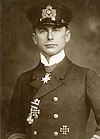
|
| Werner Fürbringer | N/A | 101[5] | 97,881[5] | Fürbringer (1888–1982) commanded a variety of small, coastal U-boats. UB-110, his last submarine, was rammed and sunk by HMS Garry on 19 July 1918. He accused the Garry's crew of firing on unarmed survivors. He also served in various posts in World War II, and was promoted to Konteradmiral in 1942, before leaving the military in 1943. | |
| Heino von HeimburgPM | N/A | 19[6] | 44,167[6] | Heimburg (1889–1945) also sank several warships: the Italian submarine Medusa, the Italian cruiser Amalfi, the British submarine HMS E20 and the French submarine Ariane, as well as two troop transports, HMT Southland and RMS Royal Edward. When HMS E7 became entangled in torpedo nets nearby, he rowed out in a small skiff and lowered a small explosive charge, forcing the British submarine to surface; the crew had to scuttle her. In World War II, he served as a vice admiral. | 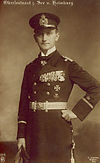
|
| Otto HersingPM | N/A | 36[7] | 79,005[7] | Hersing (1885–1960), in command of U-21, was responsible for the first sinking of a modern warship by a submarine-launched torpedo in history, sending the light cruiser HMS Pathfinder to the bottom in September 1914. He also sank the battleships HMS Triumph and HMS Majestic - earning him the nickname "Zerstörer von Schlachtschiffen" (destroyer of battleships) - the French armoured cruiser Amiral Charner and the French auxiliary cruiser Carthage. | 
|
| Hans HowaldtPM | 11 | 63[8] | 95,518[8] | Howaldt (1888–1970) commanded UC-4, UB-40 and UB-107. | 
|
| Waldemar KophamelPM | N/A | 55[9] | 157,473[9] | Kophamel (1880–1934) commanded U-35 and U-140. | |
| Johannes LohsPM † | 13 | 76[10] | 149,465[10] | Lohs (1889–1918) commanded UC-75 and UB-57. While at the helm of UB-57, he sank the armed merchant cruiser HMS Moldavia. He was killed when UB-57 was lost in the North Sea in August 1918. | |
| Wilhelm Marschall | N/A | 43[11] | 119,170[11] | Marschall (1886–1976) commanded UC-74 (1916–17) and UB-105 (1918), and received the Pour le Mérite. After WWI he continued his career in the German Navy, serving as an Admiral during WWII. | 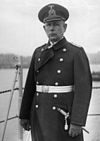
|
| Martin Niemöller | N/A | 3[12] | 9,903[12] | After serving aboard other U-boats, Niemöller (1892–1984) was given command of UC-67 in June 1918.In 1924, he was ordained a Lutheran pastor. He opposed the Weimar Republic and was initially a supporter of Adolf Hitler, but later co-founded the Confessing Church, a movement resisting Nazi efforts to control German Protestant churches, and was imprisoned in concentration camps from 1938 to 1945. He wrote the 1946 poem "First they came ..." and became a vocal pacifist and anti-war activist in later life. | 
|
| Helmut Patzig | N/A | 24[13] | 87,326[13] | Patzig (1890–1984) commanded U-86 and U-90 during 1918. As commander of U-86, he sank the Canadian hospital ship HMHS Llandovery Castle, contrary to both international law and standing orders of the Imperial German Navy. Then he ordered the ramming of lifeboats and machinegunning of survivors in an attempt to cover up the war crime. Postwar, he fled German jurisdiction and was never tried. Under the name Helmut Brümmer-Patzig, he also served in World War II in various posts, including command of the 26th U-boat Flotilla. | |
| Hans RosePM | N/A | 81[14] | 220,892[14] | Rose (1885–1969) commanded U-53 between 1916 and 1918, sinking USS Jacob Jones, the first American destroyer to be lost during the war. He commanded a U-boat training unit in 1940. | 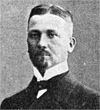
|
| Hellmuth von Ruckteschell | N/A | 20[15] | 25,985[15] | Ruckteschell (1890−1948) commanded UB-34 and U-54. He was considered by the Allies to have breached the laws of war, but left Germany and was not tried at that time. In World War II, he was one of the most successful merchant raider captains, at the helm of the auxiliary cruisers Widder and Michel. After the war, he was convicted of war crimes, for allegedly continuing to fire after merchant ships had surrendered, and was sentenced to 10 years imprisonment. However, the Royal Navy acknowledged there may have been a miscarriage of justice due to the lack of naval experience in the court: only one junior naval officer had sat as a judge. | |
| Alfred Saalwächter | N/A | 27[16] | 64,084[16] | Saalwächter (1883–1945) commanded U-25, U-46 and U-94. He remained in the navy after the end of World War I. He was promoted to Generaladmiral in January 1940 and led surface operations in World War II, including tactical command of Operation Weserübung, the invasion of Norway. | 
|
| Reinhold SaltzwedelPM † | N/A | 111[17] | 172,824[17] | Saltzwedel (1889–1917) commanded six U-boats during the war. He was killed in December 1917 when UB-81 was sunk by a mine off the Isle of Wight. | 
|
| Otto von Schrader | N/A | 57[18] | 54,663[18] | Schrader (1888–1945) commanded various U-boats. He was an admiral in World War II. | |
| Otto SchultzePM | N/A | 53[19] | 132,567[19] | Schultze (1884–1966) commanded U-63. U-63 finished off the badly damaged light cruiser HMS Falmouth, which had been torpedoed twice by U-66. He held several staff posts in the interwar period and was recalled from retirement to active service in World War II, eventually rising to the rank of Generaladmiral (equivalent to four-star admiral), before retiring again in 1942. | |
| Walther SchwiegerPM † | 34 | 49[20] | 185,212[20] | Schwieger (1885–1917) commanded U-14, U-20 and U-88. While in command of U-20, he sank the passenger liner RMS Lusitania, an event which was a key factor in the United States' eventual entry into the war. Schwieger was killed when U-88 was sunk by a British mine off the Dutch coast in September 1917. | 
|
| Edgar von Spiegel von und zu Peckelsheim | N/A | 14[21] | 36,925[21] | Spiegel (1885–1965) commanded U-32 and U-93. Appointed German consul in New Orleans in 1937, he probably radioed information about merchant shipping departures for England to U-boats stationed in the Gulf of Mexico. | |
| Otto SteinbrinckPM | N/A | 204[22] | 233,072[22] | Steinbrinck (1888–1949) commanded several submarines during World War I. After the war, he joined the Nazi Party in 1933 and became a member of the SS, rising to the rank of Brigadeführer. In 1945, he was arrested and faced charges at the Flick Trial. In December 1947, he was sentenced to six years imprisonment in Landsberg Prison, but died two years into his sentence. | 
|
| Józef Unrug | N/A | 0[23] | 0[23] | Unrug (1884–1973) commanded UB-25, UC-11 and UC-28. After Poland became a nation again in 1919, he joined its navy and was quickly made a counter admiral (equivalent to rear admiral). He fiercely resisted the German invasion of Poland, which initiated World War II, and was made a prisoner of war. | 
|
| Max ValentinerPM | N/A | 143[24] | 298,803[24] | Valentiner (1883–1949) commanded U-38 and U-157. Listed as a war criminal by the Allies for a series of incidents, including the sinking of the passenger liner SS Persia without warning, Valentiner went into hiding for a while at the end of the war. During World War II, Valentiner led a unit inspecting new U-boats before commissioning. | 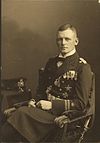
|
| Walter Warzecha | N/A | 9[25] | 22,612[25] | Warzecha (1891–1956) commanded UC-1, UC-71 and UB-148. He returned to naval service in 1920. In World War II, in 1944 he was Generaladmiral and was appointed Chef der Kriegsmarinewehr ("Chief of the Navy"). After Germany's surrender, he assumed the duties of commander-in-chief of the Kriegsmarine and presided over its dissolution. | 
|
| Otto WeddigenPM † | N/A | 4[26] | 12,934[26] | Weddigan (1882–1915) sank three British armoured cruisers - HMS Aboukir, HMS Hogue and HMS Cressy - in less than an hour. This feat, along with the sinking of the protected cruiser HMS Hawke, resulted in the award of the Pour le Mérite. He was killed when U-29 surfaced in the path of the British battleship HMS Dreadnought after firing a torpedo at another ship. After a short chase, Dreadnought rammed U-29, cutting her in two. | 
|
| Raimund Weisbach | N/A | 36[27] | 107,763[27] | As the torpedo officer of U-20, Weisbach (1886–1970) fired the torpedo that sank the British ocean liner RMS Lusitania. He was later given command of U-19 and U-81. He survived the sinking of U-81 and was a prisoner for the rest of the war. |
References[]
- ^ a b "Lothar von Arnauld de la Perière". uboat.net.
- ^ a b "Wilhelm Canaris". uboat.net.
- ^ a b "Karl Dönitz". uboat.net.
- ^ a b "Walther Forstmann". uboat.net.
- ^ a b "Werner Fürbringer". uboat.net.
- ^ a b "Heino von Heimburg". uboat.net.
- ^ a b "Otto Hersing". uboat.net.
- ^ a b "Hans Howaldt". uboat.net.
- ^ a b "Waldemar Kophamel". uboat.net.
- ^ a b "Johannes Lohs". uboat.net.
- ^ a b "Wilhelm Marschall". uboat.net.
- ^ a b "Martin Niemöller". uboat.net.
- ^ a b "Helmut Patzig". uboat.net.
- ^ a b "Hans Rose". uboat.net.
- ^ a b "Hellmuth von Ruckteschell". uboat.net.
- ^ a b "Alfred Saalwächter". uboat.net.
- ^ a b "Reinhold Saltzwedel". uboat.net.
- ^ a b "Otto von Schrader". uboat.net.
- ^ a b "Otto Schultze". uboat.net.
- ^ a b "Walther Schwieger". uboat.net.
- ^ a b "Freiherr Edgar von Spiegel von und zu Peckelsheim". uboat.net.
- ^ a b "Otto Steinbrinck". uboat.net.
- ^ a b "Józef Unrug". uboat.net.
- ^ a b "Max Valentiner". uboat.net.
- ^ a b "Walter Warzecha". uboat.net.
- ^ a b "Otto Weddigen". uboat.net.
- ^ a b "Raimund Weisbach". uboat.net.
Categories:
- U-boat commanders (Imperial German Navy)
- Lists of German military personnel